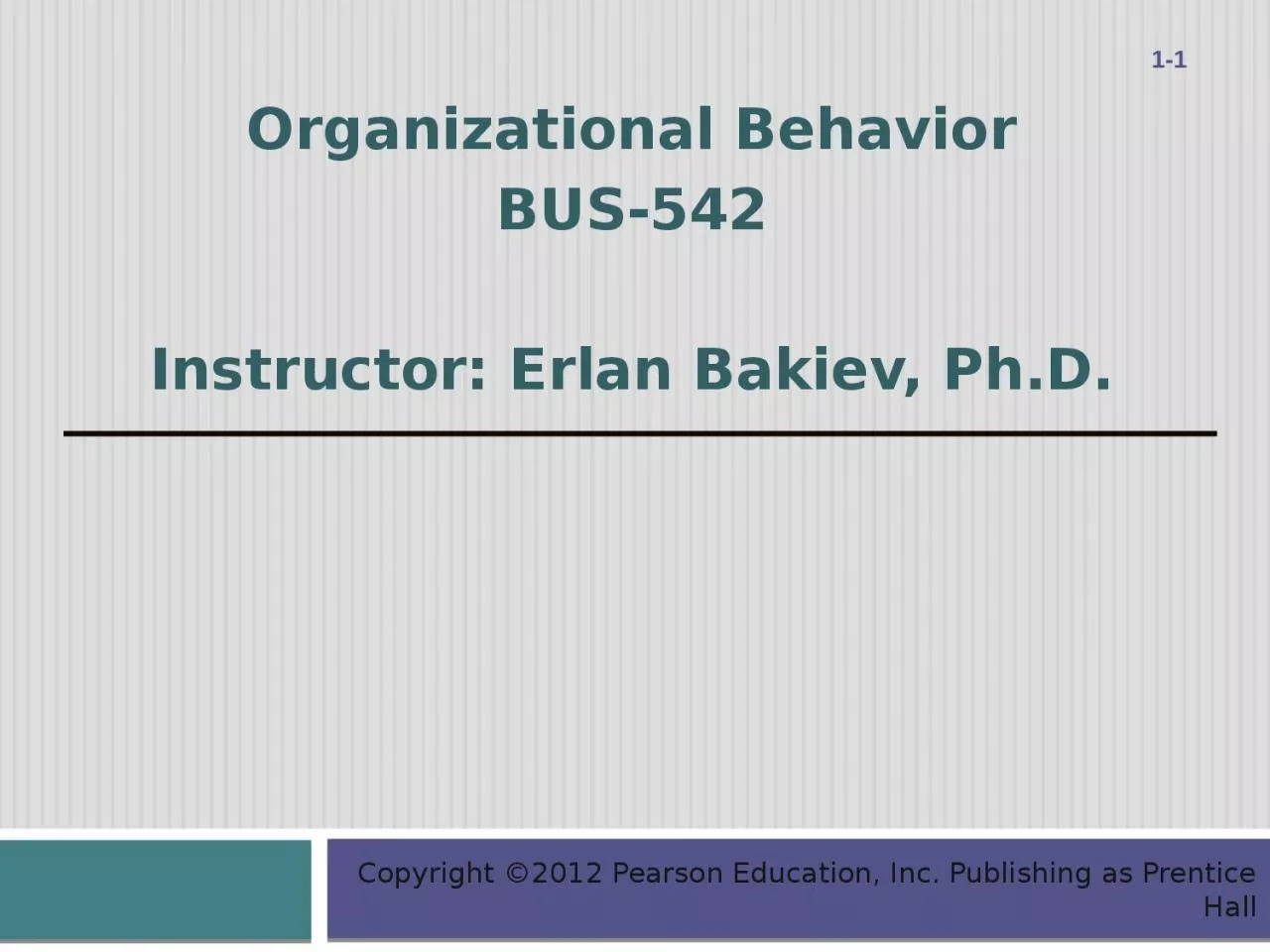

Instructor Erlan Bakiev PhD 1 1 Chapter 13 Conflict and Negotiation 13 2 Essentials of Organizational Behavior 11e Stephen P Robbins amp Timothy A Judge After studying this chapter you should be able to ID: 1018338
Download Presentation The PPT/PDF document "Organizational Behavior BUS-542" is the property of its rightful owner. Permission is granted to download and print the materials on this web site for personal, non-commercial use only, and to display it on your personal computer provided you do not modify the materials and that you retain all copyright notices contained in the materials. By downloading content from our website, you accept the terms of this agreement.
1. Organizational BehaviorBUS-542Instructor: Erlan Bakiev, Ph.D.1-1
2. Chapter 13 Conflict and Negotiation13-2Essentials of Organizational Behavior, 11/eStephen P. Robbins & Timothy A. Judge
3. After studying this chapter, you should be able to:13-3Define conflict and differentiate between the traditional, interactionist and managed-conflict views of conflict.Outline the conflict process.Contrast distributive and integrative bargaining.Apply the five steps of the negotiation process.Show how individual differences influence negotiations.Describe cultural differences in negotiations.
4. Conflict Defined13-4Process that begins when one party perceives that another party has negatively affected, or is about to negatively affect, something that the first party cares about (Thomas, 1992).
5. Transitions in Conflict Thought13-5Traditional View All conflict is harmful and must be avoidedInteractionist View Conflict is encouraged to prevent group from becoming stale (Dreu and Van de Vliert, 1997)Resolution Focused View Conflict is inevitable but we should focus on productive conflict resolution (Peterson and Behfar, 2003)
6. Functional Vs. Dysfunctional Conflict13-6Functional: improves group performanceDysfunctional: hinders group performanceAssessing Focus of Conflict:Task – work content and goalsRelationship – interpersonalProcess – how the work is done
7. Desired Conflict Levels13-7Source of ConflictLevel of ConflictLowModerateHighTaskFunctionalDysfunctionalRelationshipDysfunctionalProcessFunctionalDysfunctional
8. The Conflict Process13-8
9. Stage I: Potential Opposition 13-9Communication Barriers ExistToo Much or Too LittleStructureGroup Size, Age, Diversity Organizational Rewards, Goals, Group DependencyPersonal Variables (Glomb and Liao, 2003)Personality TypesEmotionality
10. Stage II: Cognition and Personalization 13-10Potential for conflict is actualizedParties “make sense” of conflict by defining it and its potential solutionsEmotions play a major role in shaping perceptionsPerceived Conflict – awareness needed for actualization (Pondy, 1967)Felt Conflict - emotional involvement - parties experience anxiety, tension, frustration, or hostility
11. Stage III: Intentions 13-11The decision to act in a given wayInferred (often erroneous) intentions may cause greater conflict (Baron, 1989)
12. Stage IV: Behavior13-12Where conflict becomes visibleUsually overt attempts to implement each party’s intentionsMay become an inadvertent stimulus due to miscalculations or unskilled enactmentsFunctional Conflicts: confined to lower range of continuum – subtle, indirect, and highly controlledDysfunctional Conflicts: upper range – highly destructive activities such as strikes and riots
13. Stage V: Outcomes 13-13Functional (Nijstad and Kaps, 2008; Zellmer-Brugn et al., 2008):Improves decision qualityStimulates creativity and innovationEncourages interest and curiosity Problems are airedAccepts change and self-evaluationDysfunctional:Group is less effective Cohesiveness and communications are reducedLeads to the destruction of the group
14. Creating Functional Conflict (Sommerfield, 1990)13-14Managers can reward dissent and punish conflict avoiders Managers must learn to accept bad news without sending cues that conflict is unacceptable
15. Negotiation13-15Process in which two or more parties exchange goods or services and attempt to agree on the exchange rate for them (Robbins and Judge, 2012)
16. Bargaining Strategies (Walton and McKersie, 1965)13-16
17. Distributive Bargaining Zones13-17PlayerAPlayerBB’s Resistance PointA’s Resistance PointB’s Target PointA’s Target PointB’s Aspiration RangeA’s Aspiration RangeSettlement Range
18. Necessary Conditions for Integrative Bargaining (Thomas, 1992)13-18Parties must be open with information and candid about their concernsBoth parties must be sensitive regarding the other’s needsParties must be able to trust each otherBoth parties must be willing to be flexible
19. The Negotiation Process (Bazerman and Neale, 1992;Curhan, et l., 2009)13-19BATNA
20. Individual Differences in Negotiation 13-20Personality (Amanatullah et al., 2008)Little evidence to supportDisagreeable introvert is bestMoods & Emotions (Watson and Hoffman, 1996; Walters et al., 1998)Showing anger helps in distributive negotiationsPositive moods help integrative negotiationsGenderMen are slightly betterMany stereotypes – low power positionsWomen’s self-image as negotiators is poor
21. Global Implications13-21Conflict and Culture: Insufficient research at this point Initial evidence does suggest some differences in tactics and attitudeCultural Differences in Negotiations: Negotiating styles clearly vary across national cultures
22. Implications for Managers: Managing Conflict13-22Use in the appropriate situations:Competition – quick action is vitalCollaboration – to gain commitment with consensusAvoidance – the issue is trivialAccommodation – when you’re wrongCompromise – opponents have equal power and hold mutually exclusive goals
23. Implications for Managers: Improving Negotiation Skills13-23Set Ambitious GoalsPay Little Attention to Initial OffersResearch Your OpponentAddress the Problem, Not the PersonalitiesBe Creative - Emphasize Win-Win Solutions
24. Keep in Mind…13-24Conflict is an inherent part of organizational life: probably necessary for optimal organizational functionTask conflict is the most constructiveMost effective negotiators use both types of bargaining and know the appropriate tactics
25. Summary13-25Defined conflict and differentiated between the traditional, human relations, and interactionist views of conflict.Outlined the conflict process.Contrasted distributive and integrative bargaining.Applied the five steps of the negotiation process.Showed how individual differences influenced negotiations.Described cultural differences in negotiations.